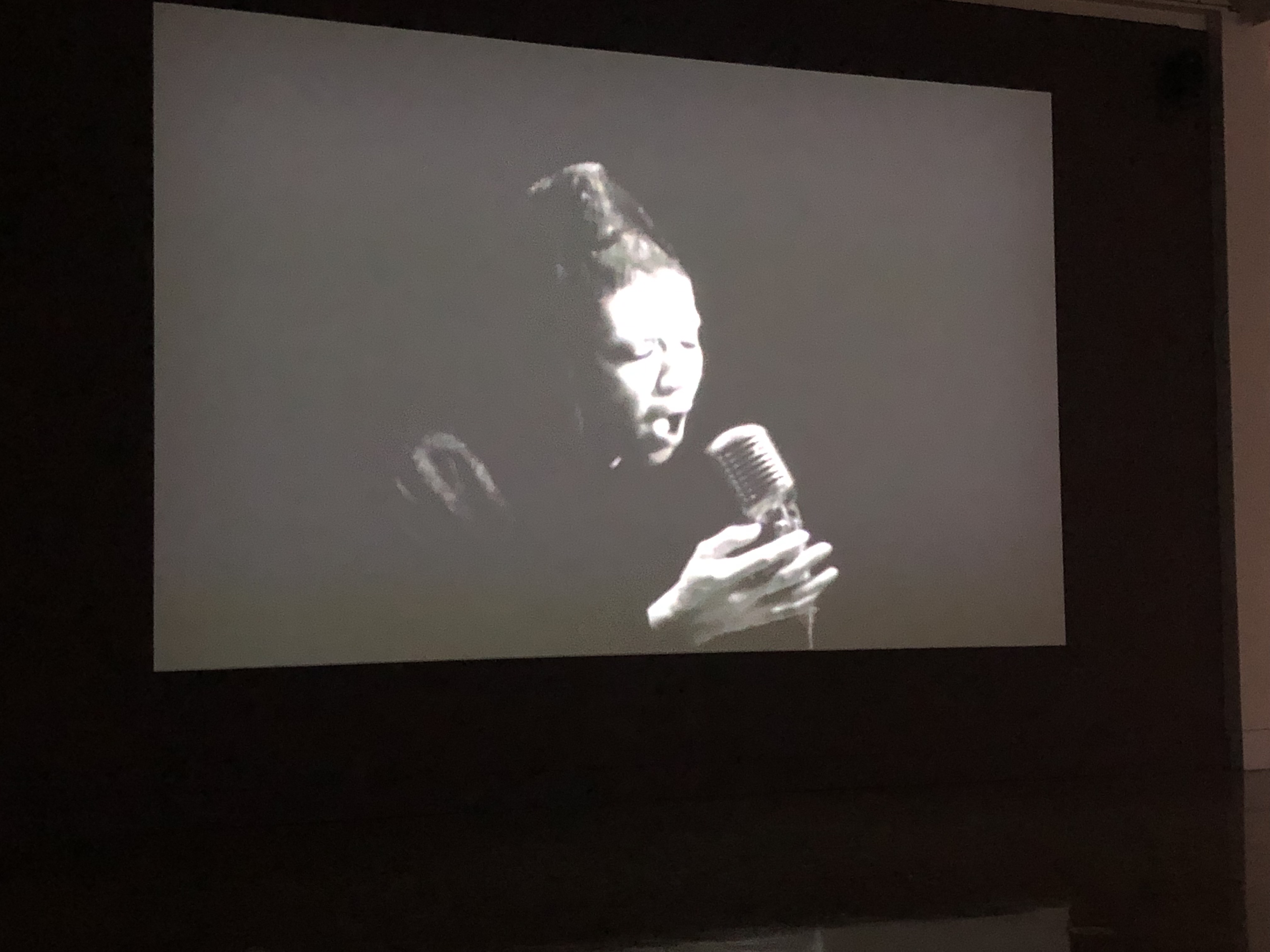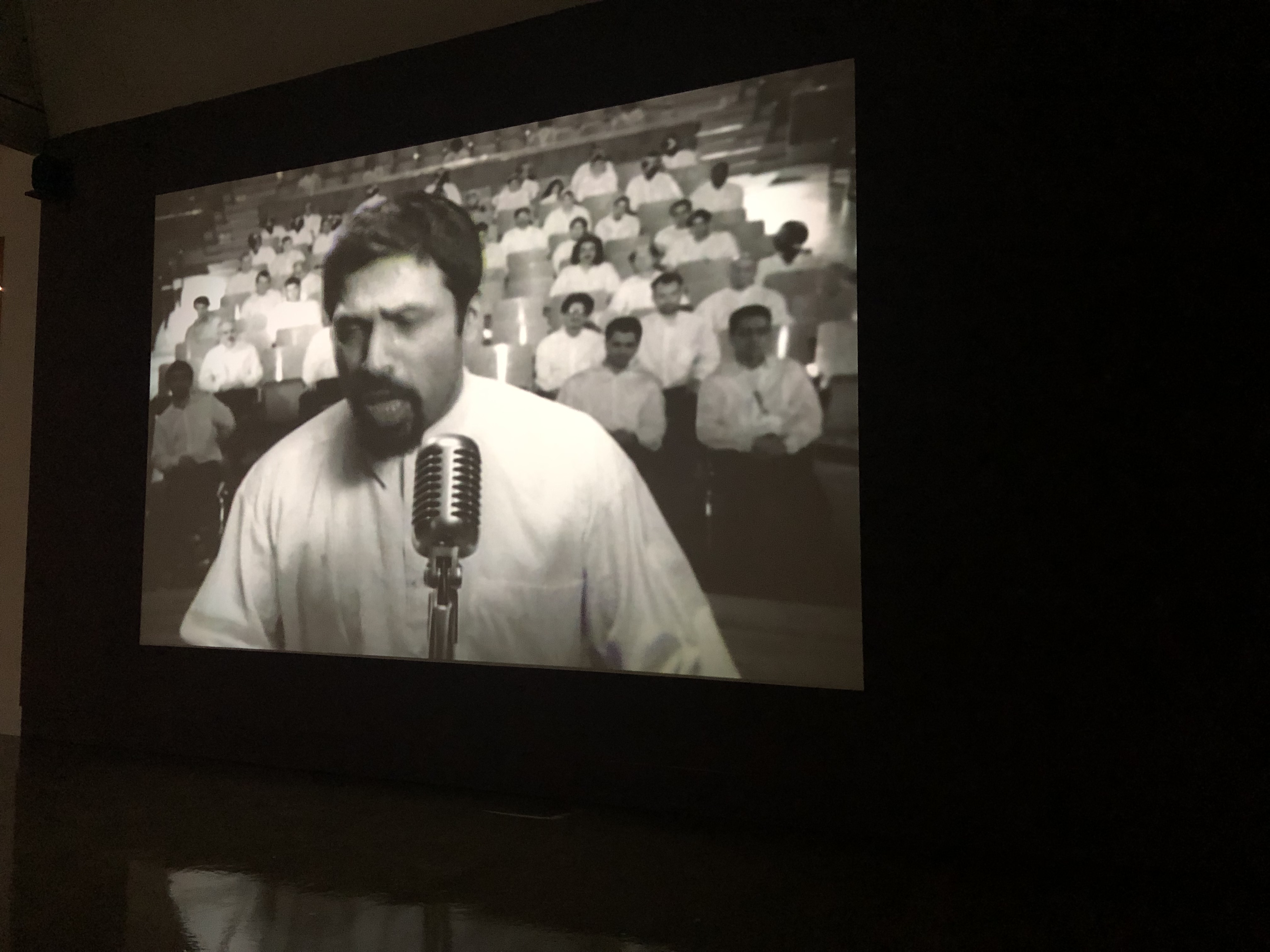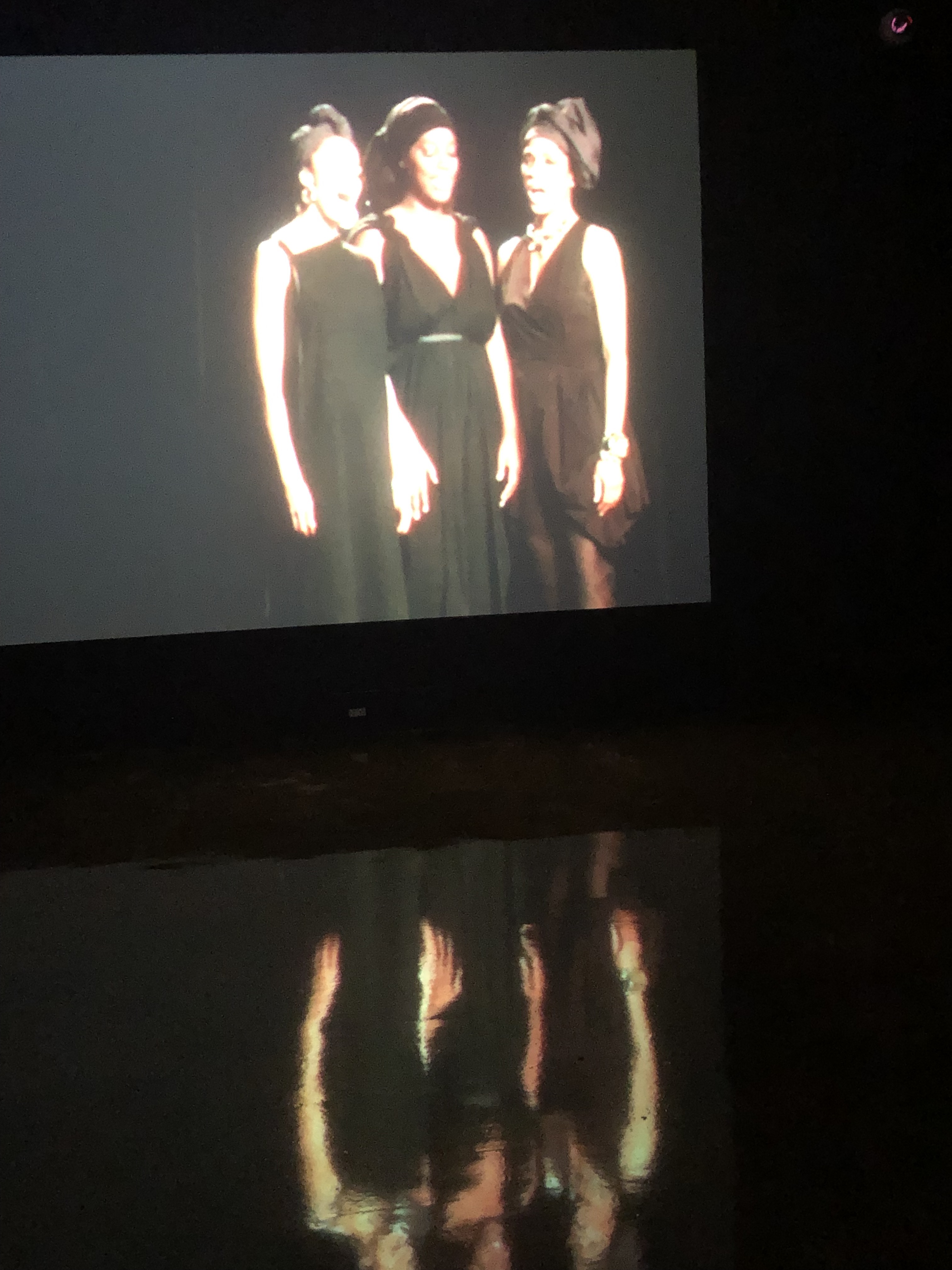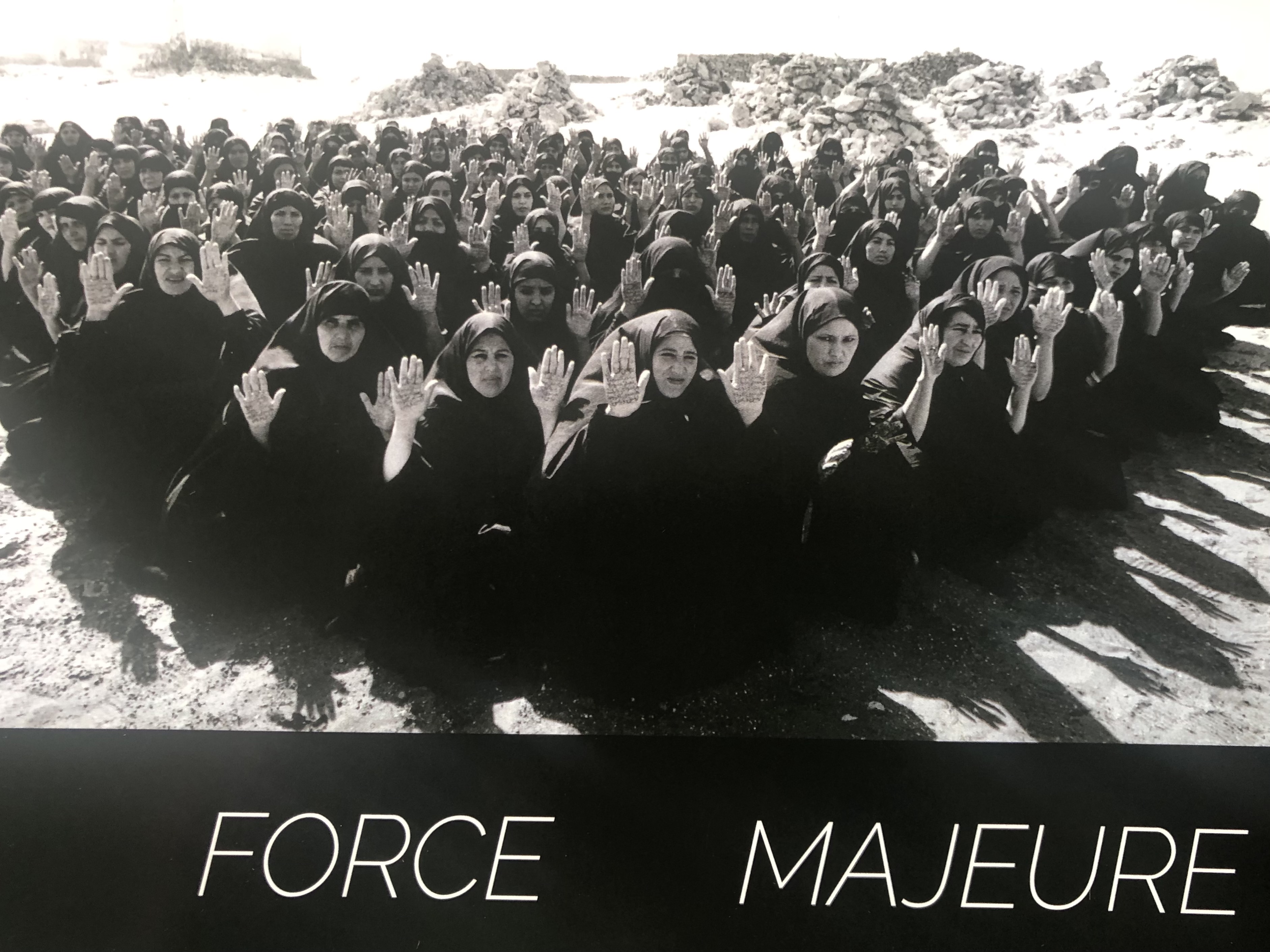I relish our corner of the Midwest. I love every corn husk that blows across the highway on my commute to work and every sunflower that just completed its exquisite display this season. But the exhibit roughly 50-miles south of Champaign-Urbana at Eastern Illinois’s Tarble Arts Center will make you think you’ve fallen down some soybean field’s rabbit hole and landed in a New York City gallery. I haven’t been to an exhibit this immersive and life-changing in our fair region in years. For art lovers and film buffs, the short films created by internationally famed artists Shirin Neshat, Hannah Black, micha cárdenas, Pipilotti Rist, Janaina Tschäpe, and Carrie Mae Weems are overwhelmingly beautiful, disturbing, provocative, and gripping. This is a must-see for anyone who can run, walk, drive, or bike to Charleston before this exhibition leaves on December 4th, 2021.
To label this an immersive experience is too tame. Shirin Neshat’s two-channel video installations greet you inside Tarble’s multi-dimensional gallery space. Neshat, the wall tags explain, is an “Iranian artist living in New York City who explores the dualities of Islamic and Western cultures, gender binaries, as well as public and private life.” The installations in this exhibition utilize dual screens to portray the limitations of Islamic law on women’s bodies versus men’s in two separate but related pieces. In one, we see men’s and women’s bodies set against a black and white Iranian landscape. In the second piece entitled Turbulent, the viewer is backstage during two very different “public” performances. The timing of the two films facing each other and working in concert is the artistry of the filmmaker and crew but it comes to life in the space thanks to the installation genius of Assistant Director and Exhibitions Curator of the Tarble, Mike Schuetz.

Turbulent, Shirin Neshat, 1998, two-channel video installation. Photo by Amy Penne.
According to Director and Chief Curator Jennifer Seas, “Mike’s genius brought this exhibit to life through sound, timing, lighting, and placement.” Seas continued, “what makes the Tarble unique is that we’re run entirely by artists. We’re working artists as well as teachers and we wanted to bring these thought-provoking videos to the people of Central Illinois. Art shouldn’t just live in galleries in big cities. This work speaks to people and we want our community to experience this conversation set, as it is, across landscapes and cultures, and inclusive of all kinds of bodies and voices.”

Turbulent, Shirin Neshat, 1998, two-channel video installation. Photo by Amy Penne.
Hannah Black’s My Bodies is a single channel video utilizing an internet sampling aesthetic to convey her focus on “global communism, feminist theory, Afropessimistic theory, the body, and sociopolitical power structures in a post-internet cultural landscape.” Black contrasts text with video and familiar sampled voices against unexpected bodies and into the crevices of human skin. The display is captivating and implicates the viewer’s body in the gallery’s dark space.
Moving through the exhibit is, in fact, part of the experience itself. Seas explains, “how you choose to orient your own body, for example, in between the two Neshat films will determine how you react to them the first time through. To get the fullest experience, you should move through the exhibit twice. It’s set up and timed that way with certain films playing simultaneously so you have to go back through to see them.”
I took her advice and did just that; the experience of the films indeed changes based on order and how you move your own body through the gallery. I missed Janaina Tschäpe’s Lacrimacorpus the first time through and found myself waiting in the ghostly black box space, another deliberate choice made by Seas and Schuetz. As Seas explained, “the ghosting is an integral part of the silence and temporal experience. It’s still there even when it’s not playing.” Tschape’s film transferred to DVD-loop with sound reflects the mythologies of the female body. The dancing figure is transformed by and into composer Franz Liszt’s music as the images collide on the German castle grounds which overlook former Nazi concentration camp, Buchenwald.
Carrie Mae Weems’ I Look At Women is another single-channel video and will be the best seven minutes you’ve spent at a film this year. Weems is one of the most influential artists of the contemporary era. Her work uses documentary-style photos and film to derail sexism and to insist on the worth, beauty, and strength of Black women. The musicality of the film baptizes the viewer in Weems’ infinite hope, which like Emily Dickinson’s “thing with feathers,” is elusive for some and just within reach for others. To be in the room with I Look At Women is to participate in a celebration of the re-visioning of women of color.

I Look At Women, Carrie Mae Weems, 2017, single-channel video. Photo by Amy Penne.
Pipilotti Rist’s videos contribute to this theme of the re-visioning of female bodies in the cyclic rhythms of life. Rist includes graphic images of live birth and vaginal tearing, with subsequent stitching, against a backdrop of “jaunty” music all pushing the viewer into the experimental cuts and wipes, which make up the grammar of her work in this show.
micha cárdenas’s Sin Sol is an augmented reality game you take out into the Tarble’s outdoor gardens to experience on an iPad available for checkout at the gallery’s far end. cárdenas, director of the UC-Santa Cruz’s Critical Realities Studio, who is working on a “new algorithm for gender, race, and technology,” also visited EIU’s campus for the Camille Compo lecture series on October 21st to discuss her work and her engagement in the aesthetics of virtual reality.
The visuals, the sounds, the feel of the gallery, and the silences in between all add up to an experience you should not miss. And if the films weren’t enough, a YOKO ONO exhibit greets you and disarms you in the Tarble’s Studio Gallery. Ono’s Mend Piece, organized by the American Federation of Arts (AFA) is “one of Ono’s innovative instruction pieces, for which she gained early recognition in the 1960’s,” according to the exhibit’s literature. This interactive space involves direct contact with concrete components as well as immersion in Ono’s thought experiments and playful, but poignant, imperatives. Plan to take the time to touch and to mend a single cup, symbolic of far more than a Crate and Barrel cup can signify. And it’s Yoko-flipping-Ono so the space and monochromatic elements stick with you long after you’ve left the center.

Mend Piece (Andrea Rosen Gallery, New York City version), Yoko Ono, 1966/2015, ceramic, nontoxic glue, tape, scissors, and twine. Copyright: 2021 American Federation of Arts. Photo by Amy Penne.
Finally, Brad Decker and Will Porter’s live performance piece, Re:hab/Re:sound remains, in parts, in the Commonspace at the front of the gallery. The piece was performed live at the Tarble’s grand re-opening but also lives here, on the Doudna Fine Arts Center’s YouTube channel. The residue from the performance resides in the space, engaging us as we enter and exit the main galleries.
Join me (of course I’m going back) on November 12th at the Tarble After Hours from 5:30 pm–8:00 pm. The Tarble will host a live DJ, dancing, refreshments, and readings from the soon-to-be-released printed companion to Force Majeure. The event is free and open to the public but RSVPs will be required.
The Tarble Arts Center is a magnificent space in general but for this exhibit, it’s simply impeccable. We are fortunate to have an exhibit like this in our corner of the prairie so plan an afternoon trip to 9th St. in Charleston on the lovely campus of Eastern Illinois University to take advantage of this extraordinary exhibition before it closes.
Tarble Arts Center
at Eastern Illinois University
2010 9th St., Charleston
Gallery Hours
W-Fi 10 a.m.-4 p.m.
Sa: 1-4 p.m.
Closed Su-Tu, holidays, and during installation periods
Free gallery admission and visitor parking.








